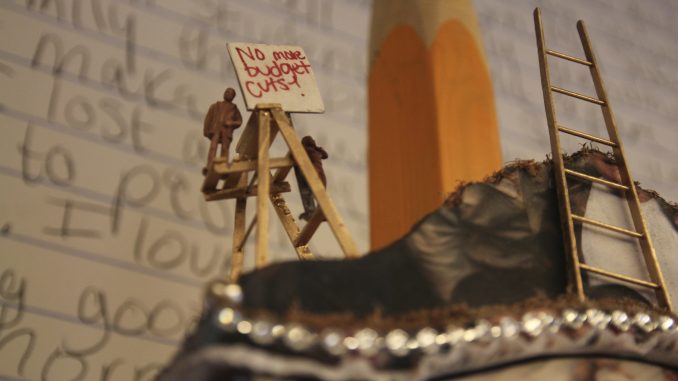
In one of the basement-level classrooms at the Tyler School of Art, a group of elementary students are fascinated to see the sink they used in their art class at Fairhill Elementary School.
It’s just one of the leftover mementos that now resides in artist Pepón Osorio’s reForm exhibition, which addresses the closing of two dozen local schools back in 2013 because of school district budget cuts. The exhibition’s opening reception to the public took place on Aug. 28, and will remain open through May 2016, Thursdays through Sundays.
Osorio, a Tyler professor, chose to center the art installation specifically on Fairhill after noticing the “decaying” building on his bike ride to Temple. That’s when he thought to use objects from the closed school building at 601 W. Somerset St.
“I started to see this building falling apart … and it caught my attention, and I began with a series of questions of, ‘What if?’” Osorio said. “Everything started with ‘What if?’”
With students’ backpacks strung up on ceiling vents, used lockers lining one of the walls and the school’s original chairs and tables filling the room, the Tyler classroom is a place of reminder for what once was for the former students, their parents and Fairhill community members.
One of Osorio’s focuses with his approach to art is connecting with the community it revolves around, and it was no different for reForm. In addition to reaching out to parents and neighbors, he worked with 10 former students, who he referred to as “Bobcats” after the school’s mascot, for an entire year. They helped him get an understanding of what the closing really meant to them.
“It’s all based on true stories,” Osorio said. “It’s all based on the relationships that I had with many of them, and it’s all based on their stories that they just wanted to say.”
Osorio said he was grateful for the community in giving him a chance to work with them so closely.
“For an outsider, someone who is completely out of this school system and not living in Fairhill community, I feel extremely welcome and honored that they opened their arms and welcomed me, and told me their stories,” he said. “That’s important for me.”
For Lynoshka Santa, one of the Bobcats who worked with Osorio, it was jarring to see how different her neighborhood seemed after Fairhill’s closing, on top of the worries her family went through in figuring out new schools for their children.
“When I was in high school and the bus stop was right there, whenever I got off, I was so used to walking home and seeing kids come out, kids running around,” Santa said. “Then after, from 11th to 12th grade, I would walk and it would just be deserted. It was different than before.”
Sheila Brown, a Temple graduate student working on her master’s in social work, attended the opening and was reminded of the concerns she had for her own children if they ever needed to change schools on such short notice, like how far they would need to travel every day.
“It can be a whole other area [and] it can be dangerous,” Brown said. “You have to think about all those other elements.”
Tonia Laster, the mother of Zayvionne Bristow, a former Fairhill student, said she was touched by the amount of work and dedication Osorio put into the installation. As she stood proudly in front of a wall bearing a drawing of the school her son made, Laster expressed sadness on how Bristow would not be able to graduate from Fairhill, her alma mater.
“I’m so grateful that [Osorio] put his heart into something that we lost because Fairhill was family-oriented,” Laster said.
As students on video exclaim their grievances at the school district through megaphone speakers along the wall, Osorio stressed that the reForm project doesn’t end with the installation. In the next nine months, the classroom will host free workshops, meetings and programming for the local community to discuss the future of Fairhill and issues related to public education.
“I thought it was important for them to raise their voice and to be able to tell the stories in their own terms,” Osorio said.
Laster has been voicing support for the abandoned Fairhill school building and its surroundings to be kept clean. She even hopes that the building will someday be used for something positive, and she encourages Temple students to be a part of the effort.
“All is welcome,” Laster said. “Anything that’s done positive is a good thing.”
On Sept. 12 from 1 to 3 p.m., as part of the reForm project’s education programming, the True Vine Baptist Church will host a talk about the Fairhill community’s rights, neighborhoods and schools.
Albert Hong can be reached at albert.hong@temple.edu or 215.2014.7416.



Be the first to comment